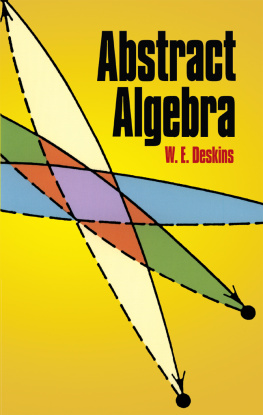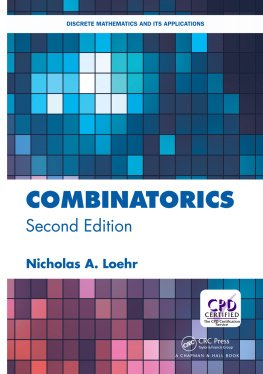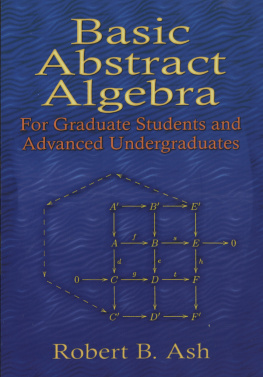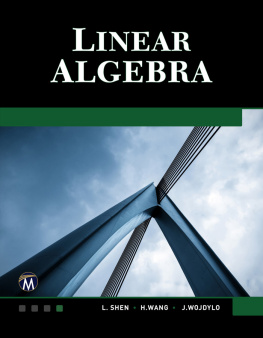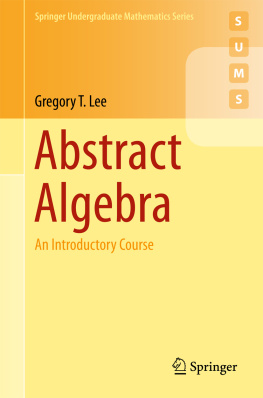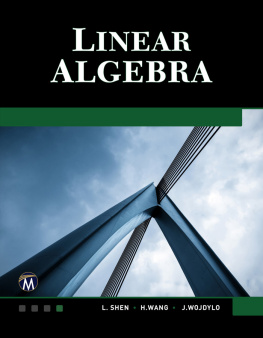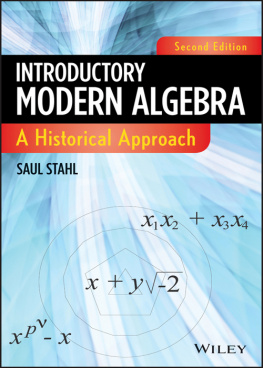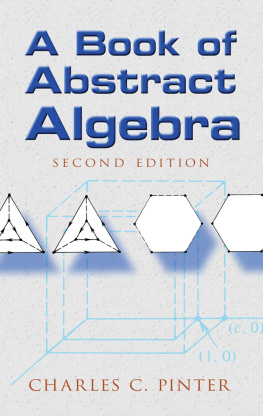W. E. Deskins - Abstract Algebra
Here you can read online W. E. Deskins - Abstract Algebra full text of the book (entire story) in english for free. Download pdf and epub, get meaning, cover and reviews about this ebook. year: 2013, publisher: INscribe Digital;Dover Publications, genre: Home and family. Description of the work, (preface) as well as reviews are available. Best literature library LitArk.com created for fans of good reading and offers a wide selection of genres:
Romance novel
Science fiction
Adventure
Detective
Science
History
Home and family
Prose
Art
Politics
Computer
Non-fiction
Religion
Business
Children
Humor
Choose a favorite category and find really read worthwhile books. Enjoy immersion in the world of imagination, feel the emotions of the characters or learn something new for yourself, make an fascinating discovery.
- Book:Abstract Algebra
- Author:
- Publisher:INscribe Digital;Dover Publications
- Genre:
- Year:2013
- Rating:3 / 5
- Favourites:Add to favourites
- Your mark:
- 60
- 1
- 2
- 3
- 4
- 5
Abstract Algebra: summary, description and annotation
We offer to read an annotation, description, summary or preface (depends on what the author of the book "Abstract Algebra" wrote himself). If you haven't found the necessary information about the book — write in the comments, we will try to find it.
This excellent textbook provides undergraduates with an accessible introduction to the basic concepts of abstract algebra and to the analysis of abstract algebraic systems. The author features many examples and a large number of problems of varying levels of difficulty at the end of each chapter.
Abstract Algebra — read online for free the complete book (whole text) full work
Below is the text of the book, divided by pages. System saving the place of the last page read, allows you to conveniently read the book "Abstract Algebra" online for free, without having to search again every time where you left off. Put a bookmark, and you can go to the page where you finished reading at any time.
Font size:
Interval:
Bookmark:
ABSTRACT
ALGEBRA W.E. DESKINS Professor of Mathematics
University of Pittsburgh DOVER PUBLICAITONS, INC. New York Copyright Copyright 1964, 1992 by W.E. Deskins. All rights Reserved. Library of congress Cataloging-in-Publication Data Deskins, W. E. E.
Abstract algebra / W.E. Deskins. p. cm. Unabridged, corrected republication of: Abstract algebra. New York: Macmillan, 1964.
Includes bibliographical references (p. ) and index. eISBN 13: 978-0-486-15846-4 1. Algebra. 2. I. I.
Deskins, W. E. Abstract algebra. II. Title. QA155.D43 1995 512.02dc20 9538346
CIP Manufactured in the United States by Courier Corporation
68888705
www.doverpublicaitons.com To the memory of CYRUS COLTON MacDUFFEE Contents The real number system An asterisk (*) indicates sections or chapters containing material which is not essential to the understanding of the principal ideas in subsequent chapters.
Preface The purpose of this book is to provide college and university students of mathematics with an accessible yet nontrivial introduction to those concepts which are basic to abstract algebra or the analysis of abstract algebraic systems. These systems, which consist of sets of elements, operations on and relations among the elements, and descriptive axioms, are abstractions and generalizations of various models which evolved from efforts to explain or discuss physical phenomena and as such occupy a prominent position in modern mathematics and science. After a discussion of the essential ingredients of a mathematical system in the first chapter, we proceed with a development and investigation of the familiar number systems in the next four chapters. This number theoretic approach to modern algebra is particularly advantageous since it enables us to demonstrate the axiomatic development of a system and to illustrate important methods, constructions, proofs, and ideas while dealing with one of the beautiful and fascinating portions of classical mathematics. (In additional topics in number theory are treated.) The resulting theory provides us with examples and guidelines which are used in the analysis of such important systems as groups, rings, fields, integral domains, polynomial rings, vector spaces, rings of linear transformations, and matric rings, and this enables us to point out and emphasize the role of analogy in the extension and development of mathematics. Moreover, from number theoretic considerations comes one of the basic unifying concepts of abstract algebra, namely, the idea of factorization and decomposition.
From the study of the factorization and decomposition of the ordinary integers we progress, via the notion of congruence, to the study of the decomposition of a system relative to a subsystem or collection of subsystems. Thus the concept of factorization and decomposition provides the central, unifying theme for our investigations of algebraic systems in this book. The resulting accentuation of the uses of subsystems and quotient systems (or homomorphic images) in the analysis of mathematical systems is very important to the development of the students appreciation of present-day research in pure and applied mathematics. The program adopted here of dealing initially with familiar systems in a careful, although somewhat sophisticated, fashion allows the student to assimilate the basic language and ideas of abstract algebra while maintaining contact with his previous mathematical experience. As more complex and abstract systems and concepts are presented for study and as the analysis becomes more difficult, numerous examples and heuristic discussions are included to assist the student to an understanding of the material. Problems follow each section in considerable quantity and provide additional material for classroom discussion as well as a challenge to the student (who is not expected to do all of the problems, which range from routine to difficult).
Also, a list of several short articles and books that should prove helpful to the student in his studies and to the instructor is given at the end of each chapter. All in all, this book represents an effort to make accessible to the interested student a considerable body of significant results, methods, ideas, and questions from abstract algebra. The inclusion of many examples and exercises and the treatment of a number of interrelated and important topics have naturally resulted in a book of some size. Therefore it is inevitable that a person or class using this book will have to omit certain sections or chapters. For this reason a diagram is included (opposite page) to indicate the interdependence of the chapters. (The remainder of the diagram should be easily interpreted from this.) In addition to this schematic aid, I have marked with an asterisk in the Table of Contents those chapters and sections treating of material which is not particularly utilized in subsequent chapters. (The remainder of the diagram should be easily interpreted from this.) In addition to this schematic aid, I have marked with an asterisk in the Table of Contents those chapters and sections treating of material which is not particularly utilized in subsequent chapters.
Experience in teaching senior students at Michigan State University from a preliminary version of this work indicates that there is enough material here for a one-year course, plus special assignments for superior and interested students. Certainly provide enrichment and interesting diversions and supplements. I should like to express here my gratitude to the many students who worked through the barely legible preliminary version of this book and offered interesting and helpful criticisms, suggestions, and encouragements; to my excellent typist, Frau Jetter of Tbingen, Germany; to my friend and colleague Professor J. Adney, for his many helpful discussions and suggestions; and to Professor James H. Bennett of The University of Michigan for his critical reading of the first two chapters. E. E.
Deskins East Lansing, Michigan. 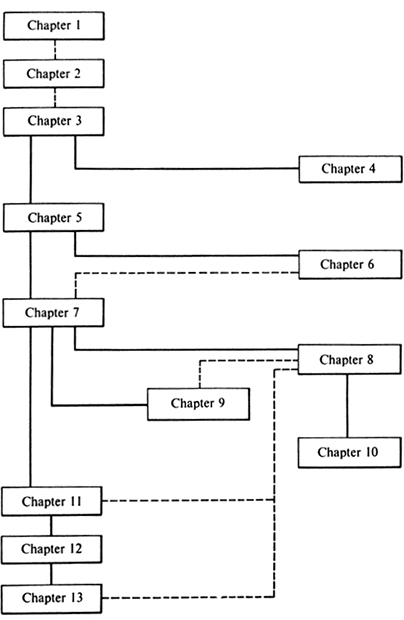 A Common Language O UR AIM IN this book is basically a very simple one: to show how the familiar methods and ideas used in the analysis of the system of whole numbers have been and are being extended and generalized to enable more diverse mathematical systems to be analyzed. In particular the concept of factorization or decomposition into simpler pieces underlies essentially all of our efforts. However, before we can proceed with this program of study we must try to establish a common starting point and path of approach. Even before doing this we must agree upon some basic assumptions, terms, and notations, and these are set down in this chapter. (A collection of problems is included in each section, and a suggested reading list is included at the end of each chapter.) Apart from the assumptions and agreements which are discussed in the following sections, we shall assume that there is a general understanding of the logical reasoning involved in proceeding from hypotheses to conclusions. (A collection of problems is included in each section, and a suggested reading list is included at the end of each chapter.) Apart from the assumptions and agreements which are discussed in the following sections, we shall assume that there is a general understanding of the logical reasoning involved in proceeding from hypotheses to conclusions.
A Common Language O UR AIM IN this book is basically a very simple one: to show how the familiar methods and ideas used in the analysis of the system of whole numbers have been and are being extended and generalized to enable more diverse mathematical systems to be analyzed. In particular the concept of factorization or decomposition into simpler pieces underlies essentially all of our efforts. However, before we can proceed with this program of study we must try to establish a common starting point and path of approach. Even before doing this we must agree upon some basic assumptions, terms, and notations, and these are set down in this chapter. (A collection of problems is included in each section, and a suggested reading list is included at the end of each chapter.) Apart from the assumptions and agreements which are discussed in the following sections, we shall assume that there is a general understanding of the logical reasoning involved in proceeding from hypotheses to conclusions. (A collection of problems is included in each section, and a suggested reading list is included at the end of each chapter.) Apart from the assumptions and agreements which are discussed in the following sections, we shall assume that there is a general understanding of the logical reasoning involved in proceeding from hypotheses to conclusions.
Although we shall at times discuss the various forms in which a theorem can be stated and will always try to set forth the important features of each proof, neither a formal treatment of logic nor the use of formal logic appears in this book. 1.1 Sets Any discussion must involve words and ideas which either have been agreed upon as undefined and undefinable or have been defined by using such primitives. These undefined terms, which can be somewhat arbitrarily selected, take on meaning from the assumptions or axioms which describe the undefined objects by stating relations between them. The axioms naturally are used to prove conclusions or theorems concerning the undefined terms and the objects which have been defined by using the undefined terms. In this manner a theory is developed. We begin with the undefined notions of
Next pageFont size:
Interval:
Bookmark:
Similar books «Abstract Algebra»
Look at similar books to Abstract Algebra. We have selected literature similar in name and meaning in the hope of providing readers with more options to find new, interesting, not yet read works.
Discussion, reviews of the book Abstract Algebra and just readers' own opinions. Leave your comments, write what you think about the work, its meaning or the main characters. Specify what exactly you liked and what you didn't like, and why you think so.

